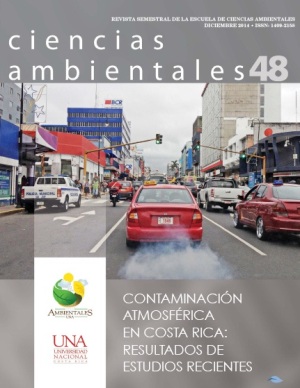Comparación de la composición química de partículas PM10 y PM2,5 colectadas en ambientes urbanos y zonas volcánicas del área metropolitana de Costa Rica
DOI:
https://doi.org/10.15359/rca.48-2.5Palavras-chave:
PM10, PM2, 5, contaminación atmosférica, contaminación urbana, partículas volcánicasResumo
Se muestrearon en forma simultánea partículas PM10 y PM2,5 en ambientes urbanos y volcánicos del área metropolitana de Costa Rica, durante octubre y noviembre de 2012. En las áreas industriales y comerciales de alto flujo vehicular (La Uruca, Heredia y Belén) se presentaron concentraciones másicas significativamente superiores (42 – 29 µgm-3) de PM10 y PM2,5 en comparación con las registradas en la zona volcánica. Las concentraciones diarias de PM10 y PM2,5 obtenidas en el volcán Poas variaron entre 3 -14 µgm-3 y 2 - 11 µgm-3, respectivamente. Sin embargo, la acidez de las partículas colectadas en el Poás es mayor a las correspondientes a ambientes urbanos debido probablemente a una ocurrencia menor de tasas de neutralización. El aporte de iones secundarios resultó ser la principal contribución (40%) a la composición de las PM10 volcánicas a diferencia de las colectadas en centros urbanos.
Referências
De Kok, T., Driece, H. A. L., Hogervorst, J. G. F. y Briedé J. J. (2006). Toxicological assessment of ambient and traffic-related particulate matter: A review of recent studies. Mutation Research 613, 103-122. http://dx.doi.org/10.1016/j.mrrev.2006.07.001
Englert, N. (2004). Fine particles and human health: a review of epidemiological studies. Toxicology Letters 149, 235-242. http://dx.doi.org/10.1016/j.toxlet.2003.12.035
Forster, P., Ramaswamy, V., Artaxo, P., Berntsen, T., Betts, R., Fahey, D. W., Haywood, J., Lean, J., Lowe, D. C., Myhre, G., Nganga, J., Prinn, R., Raga, G., Schulz, M. y Van Dorland, R. (2007). Changes in Atmospheric Constituents and in Radiative Forcing. En: Solomon, S., Qin, D., Manning, M., Chen, Z., Marquis, M., Averyt, K. B., Tignor, M. y Miller, H. L. (Eds.) Climate Change 2007: The Physical Science Basis. [Contribution of Working Group I to the Fourth Assessment Report of the Intergovernmental Panel on Climate Change]. Cambridge y New York: Cambridge University Press.
Herrera, J. (2009). Primer inventario de emisiones de contaminantes criterio del área Metropolitana: a-o 2007. CCAD-USAID.
Hueglin, C., Gehrig, R., Baltensperger, U., Gysel, M., Monn, C. y Vonmont, H. (2005). Chemical characterization of PM2,5, PM10 and coarse particles at urban, near city and rural sites in Switzerland. Atmospheric Environment 39, 637‐651. http://dx.doi.org/10.1016/j.atmosenv.2004.10.027
Husain, L., Dutkiewicz, V. A., Khan, A. J. y Ghauri, B. M. (2007). Characterization of carbonaceous aerosols in urban air. Atmospheric Environment 41, 6872-6883. http://dx.doi.org/10.1016/j.atmosenv.2007.04.037
Jacobson, M. Z. (2002). Atmospheric pollution. History, science and regulation. Cambridge: Cambridge University Press. http://dx.doi.org/10.1017/CBO9780511802287
Janssen, N. A. H., Brunekreef, B., Vliet, P., Arts, F., Meliefste, K., Harssema, H. y Fischer, P. (2003). The relationship between air pollution from heavy traffic and allergic sensitization, bronchial hyperresponsiveness, and respiratory symptoms in Duth schoolchildren. Environmental Health Perspectives 111, 1512-1518. http://dx.doi.org/10.1289/ehp.6243
Kampa, M. y Castanas, E. (2008). Human health effects of air pollution. Environmental Pollution 151, 362-367. http://dx.doi.org/10.1016/j.envpol.2007.06.012
Kappos, A. D., Bruckmann, P., Erikmann, T., Englert, N., Heinrich, U., Höppe, P., Koch, E., Krause, G., Kreyling, W. G., Rauchfuss, K., Rombout, P., Schulz- Klemp, V., Thiel, W. R. y Wichman H. E. (2004). Health effects of particles in ambient air. International Journal Hygiene and Environmental Heath 207, 399-407. http://dx.doi.org/10.1078/1438-4639-00306
Lee, J. T., Son, J. Y. y Cho, Y. S. (2007). The adverse effects of fine particle air pollution on respiratory function in the elderly. Science of the Total Environment 385, 28-36. http://dx.doi.org/10.1016/j.scitotenv.2007.07.005
Peters, A. (2005). Review: Particulate matter and heart disease Evidence from epidemiological studies. Toxicology and Applied Pharmacology 207, S477-S482. http://dx.doi.org/10.1016/j.taap.2005.04.030
Pope III, C. A., Burnett, R. T., Thun, M. J., Calle, E. E., Krewski, D., Ito, K. y Thurston, G. D. (2002). Lung cancer, cardiopulmonary mortality, and long-term exposure to fine particulate air pollution. American Medical Association 287, 1132-1141. http://dx.doi.org/10.1001/jama.287.9.1132
Rosenfeld, D. (2000). Suppression of rain and snow by urban and industrial air pollution. Science 287, 1793-1796. http://dx.doi.org/10.1126/science.287.5459.1793
Terzi, E., Argyropoulos, G., Bougatioti, A., Mihalopoulos, N., Nikolaou, K. y Samara, C. (2010). Chemical composition and mass closure of ambient PM10 at urban sites. Atmospheric Environment 44, 2231‐2239. http://dx.doi.org/10.1016/j.atmosenv.2010.02.019
Turpin, B. J. y Lim, H. J. (2001). Species contributions to PM2,5 mass concentrations: revisiting common assumptions for estimating organic mass. Aerosol Science and Technology 35, 602‐610.
Downloads
Publicado
Como Citar
Edição
Seção
Licença
A partir del 17 de mayo del 2018 la licencia ha sido actualizada a:

Esta obra está bajo una Licencia Creative Commons Atribución-NoComercial-CompartirIgual 4.0 Internacional.















